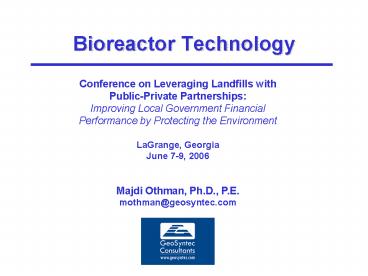Bioreactor Technology - PowerPoint PPT Presentation
1 / 20
Title:
Bioreactor Technology
Description:
From SWANA Presentation by Gary Hater of WMI (2006) Additional Costs of Bioreactors ... bioreactor landfill were estimated to be $3.5 million by Hater, et. al. ... – PowerPoint PPT presentation
Number of Views:338
Avg rating:3.0/5.0
Title: Bioreactor Technology
1
Bioreactor Technology
Conference on Leveraging Landfills
with Public-Private Partnerships Improving Local
Government Financial Performance by Protecting
the Environment LaGrange, Georgia June 7-9,
2006 Majdi Othman, Ph.D., P.E. mothman_at_geosyntec
.com
2
Presentation Outline
- Background
- Bioreactor Concept
- Types of Bioreactors
- Benefits of Bioreactors
- Additional Costs of Bioreactors
- Conclusion
3
Background-Use of Technology
Partial List of Landfills that applied
leachate recirculation or bioreactor technology
in the U.S.
- Over 50 leachate recirculation and bioreactor
landfills in the U.S. - Recent Passage of EPAs Research, Development,
and Demonstration (RDD) Rule, created more
opportunity to operate old and new landfill cells
as bioreactors. - EPA and many states have recognized the
environmental benefits of liquid addition. - Owners recognize the significant benefits.
- Guidance, regulation, and technical support are
needed to support this technology.
4
BackgroundWaste Degradation Process
I Initial Adjustment II Transition III Acid
IV Methane Fermentation V Maturation
5
Bioreactor Concept
- Bioreactor technology accelerates the biological
decomposition of food, paper and other organic
wastes in a landfill by significantly increasing
the moisture content in the landfill. The liquids
create optimum conditions for the microorganisms
to rapidly degrade the solid waste. - 40-60 gallons of added liquid per ton of solid
waste increases the water content of the waste
from about 20 to about 40-50.
6
Bioreactor Concept
7
Types of Bioreactors
- Anaerobic
- Aerobic
- AerobicAnaerobic
8
Anaerobic Bioreactor
- Degradation of waste is accelerated by optimizing
conditions for anaerobic bacteria - The anaerobic bacteria converts organic wastes
into organic acids and ultimately into methane
and carbon dioxide. - Moisture is typically added in the form of
leachate through a variety of delivery systems. - Additional sources of moisture such as sewage
sludge, storm water, and other non-hazardous
liquid wastes may be necessary to augment the
leachate available for recirculation.
9
Aerobic Bioreactor
- Accelerates waste degradation by optimizing
conditions for aerobes which are organisms that
require oxygen for cellular respiration. - Energy is delivered from organic molecules in a
process that consumes oxygen and produces carbon
dioxide. - Aerobes require sufficient water to function just
as anaerobes do. - In landfills, aerobic activity is promoted
through injection of air into the waste mass.
Liquids are typically added through leachate
recirculation.
10
Aerobic-Anaerobic Bioreactor
- Rapid biodegradation of organic waste in the
aerobic stage to reduce organic acids in the
anaerobic stage resulting in the earlier onset of
the methane fermentation phase. - The uppermost lift or layer of waste is aerated,
while the lift immediately below it receives
liquids. - Landfill gas is extracted from each lift below
the lift receiving liquids. - Horizontal wells that are installed in each lift
during construction are used to transport air,
liquids, and landfill gas.
11
Benefits of Bioreactors
12
Benefits of BioreactorsRapid Stabilization of
the Waste Mass
13
Benefits of BioreactorsEnhancement of Landfill
Gas Generation for Gas to Energy Projects
14
Benefits of BioreactorsEnhancement of Landfill
Gas Quality for Gas to Energy Projects
Source Yolo County, CA
15
Benefits of BioreactorsImprovement of Leachate
Quality
Source Reinhart and Al-Yousfi, 1997.
16
Benefits of BioreactorsIncreased Waste Settlement
17
Benefits of BioreactorsIncreased Waste Settlement
18
Benefits of BioreactorsIncreased Waste
Settlement leads to Increased Landfill Capacity
From SWANA Presentation by Gary Hater of WMI
(2006)
19
Additional Costs of Bioreactors
- Added costs may include
- Larger leachate management system components
(pumps, piping etc.) - Installation of leachate recirculation
trenches/wells and associated piping - alternative daily cover
- alternative interim cover (e.g., exposed
geomembrane) - Operation costs for bioreactor (personnel,
equipment, etc.) - Additional monitoring (leachate quality and
quantity, additional LFG quantity, etc.) - Additional maintenance (seep repairs, odor
prevention) - Additional capital costs for a 1,150 tpd
bioreactor landfill were estimated to be 3.5
million by Hater, et. al. - Actual cost is very site-specific.
20
Conclusions
- Landfills can be successfully operated as
bioreactors through proper design and operations. - Bioreactor technology has many benefits
including - Accelerated and more complete decomposition of
waste - Associated settlement/capacity gain
- Enhanced gas generation for LFGTE projects
- Less leachate to treat
- Less contamination potential after landfill is
closed - Less long-term risk
- Reduced post-closure care requirements
- Bioreactors need additional capital and
operations costs.































